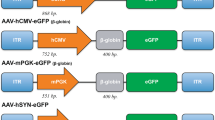Abstract
In this study, we have evaluated the capacity of recombinant adeno-associated virus (rAAV) vectors, containing cell type-specific promoters, to transduce neurons in vivo in the normal adult rat spinal cord. The neuron-specific enolase (NSE) promoter and the platelet-derived growth factor (PDGF) B-chain promoter were used to direct expression of a ‘humanized’ form of the gene for green fluorescent protein (GFP). Neuron-specific rAAVs were injected into the mid-cervical regions of adult rat spinal cords. At 10–14 days, expression was detected in all animals and persisted for up to 15 weeks. Immunocytochemical and morphological profiles of transduced cells were consistently neuronal, and there was no evidence of transgene expression in glial elements. Transduction efficiencies for the NSE and PDGF rAAVs were estimated at 15 and 45 infectious particles per GFP-positive neuron, respectively, in the absence of detectable adenovirus. This study strongly supports a role for rAAV vectors in CNS gene therapy and lays the groundwork for delivery of more functional genes to spinal cord neurons as a possible way to enhance spinal cord repair following injury.
Similar content being viewed by others
Author information
Authors and Affiliations
Rights and permissions
About this article
Cite this article
Peel, A., Zolotukhin, S., Schrimsher, G. et al. Efficient transduction of green fluorescent protein in spinal cord neurons using adeno-associated virus vectors containing cell type-specific promoters. Gene Ther 4, 16–24 (1997). https://doi.org/10.1038/sj.gt.3300358
Received:
Accepted:
Issue Date:
DOI: https://doi.org/10.1038/sj.gt.3300358
- Springer Nature Limited
Keywords
This article is cited by
-
PEG-mediated transduction of rAAV as a platform for spatially confined and efficient gene delivery
Biomaterials Research (2022)
-
Lighting Up Neural Circuits by Viral Tracing
Neuroscience Bulletin (2022)
-
Improving hindlimb locomotor function by Non-invasive AAV-mediated manipulations of propriospinal neurons in mice with complete spinal cord injury
Nature Communications (2021)
-
Neuroanatomical tract-tracing techniques that did go viral
Brain Structure and Function (2020)
-
Effects of Ethanol Exposure on the Neurochemical Profile of a Transgenic Mouse Model with Enhanced Glutamate Release Using In Vivo 1H MRS
Neurochemical Research (2019)




